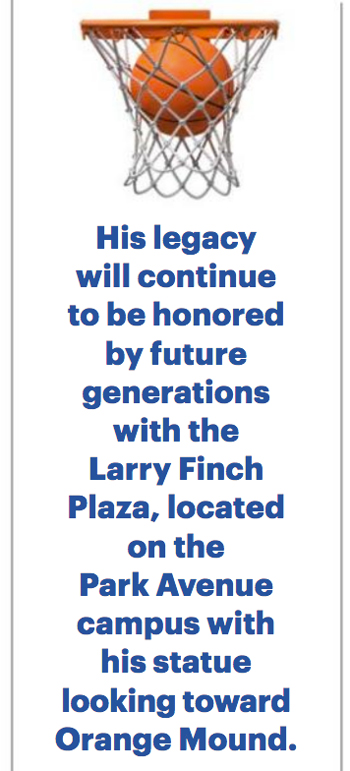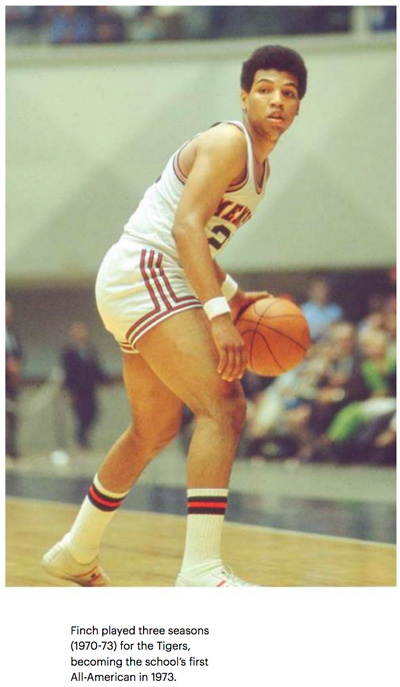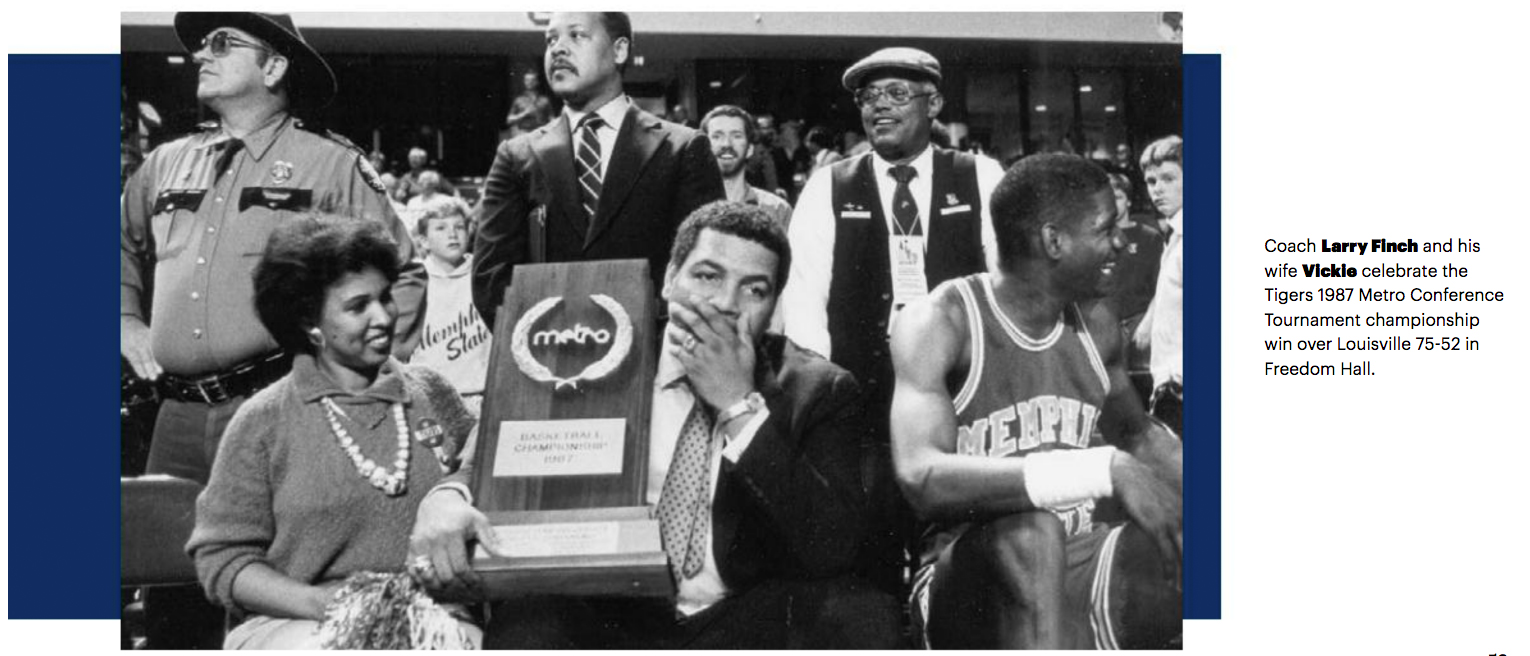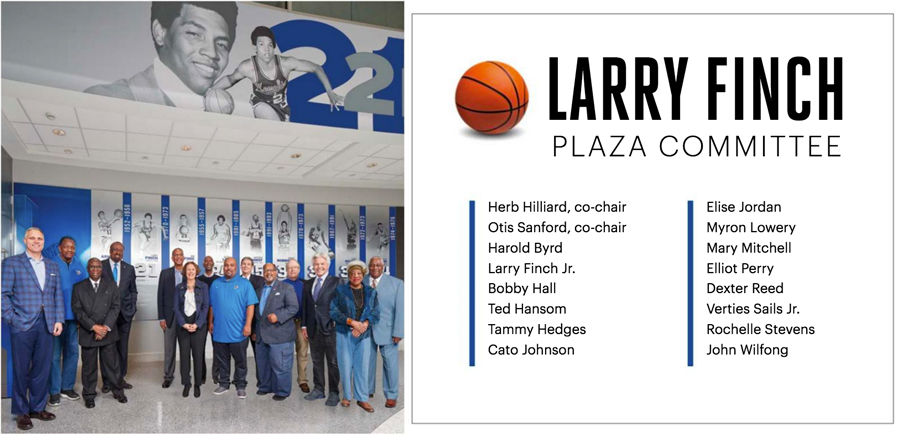UofM Magazine
Popular argument game: pick a sport or team and name the faces on its Mount Rushmore.
University of Memphis Tiger basketball? Larry O. Finch is front and center. No argument there...
Or is there? Would it be the confident youngster with the silk-smooth jumper who led Memphis State to its first NCAA Finals in 1973? Or the guy in a suit and tie who righted Memphis’ ship in the 1980s, coaching eight players on to the NBA, and a much larger group to graduation and on to lives as productive adults?
Overlay the context of his City of Memphis’ often tumultuous, sometimes tortured history — and how often the kid from Orange Mound came to the rescue. Now the question is, was it ever just about basketball?
Answer? A resounding no. With that in mind, the University will dedicate a plaza in front of the Laurie-Walton Family Basketball Center on the Park Avenue Campus in October 2020. It will honor the legacy of a man who brought fame and honor to his alma mater, and excitement and healing to his hometown— always with a healthy dose of laughter.
“He IS the native son,” said current Tiger coach Penny Hardaway (aka Finch 2.0?). “He’s the one who got guys like myself to want to come to the school because he was from Memphis, from Orange Mound. From a player to an assistant to a head coach, this was his whole life.”
 UofM President M. David Rudd has appointed a 16-member committee to draw up plans
for a statue and multimedia exhibit that will showcase all of the ways that Finch
impacted his school and hometown.
UofM President M. David Rudd has appointed a 16-member committee to draw up plans
for a statue and multimedia exhibit that will showcase all of the ways that Finch
impacted his school and hometown.
“Larry Finch embodies the City of Memphis,” said Rudd. “From growing up in Orange Mound to unifying the city by attending then-Memphis State University to coaching his alma mater at the University of Memphis, Larry Finch and his spirit are what make our city so special.
“His legacy will continue to be honored by future generations with the Larry Finch Plaza, located on the Park Avenue campus with his statue looking toward Orange Mound.
“The Larry Finch Plaza committee consists of community members who were close to the former Tiger All-American. The statue and plaza will be one we will all cherish forever.”
Herb Hilliard, a committee co-chair and chairman of the National Civil Rights Museum, was the first African-American to play for the Tigers in 1965. “Let’s be honest,” he says with a smile, “Larry was a heck of a player. I was average at best. There were some better athletes or players than Larry, but he is synonymous with Memphis basketball. This should have been done a long time ago.”
 It goes much deeper than the then-school record 1,869 points — currently fourth all-time
— Finch scored from 1970-73, or becoming the school’s first basketball All-American.
Finch’s 22.3 points per game career average is still a Tiger record. After Dr. Martin
Luther King Jr.’s murder on the balcony of the Lorraine Motel in 1968, racial tensions
were never far from a boil, and the city seemed intent on tearing itself apart.
It goes much deeper than the then-school record 1,869 points — currently fourth all-time
— Finch scored from 1970-73, or becoming the school’s first basketball All-American.
Finch’s 22.3 points per game career average is still a Tiger record. After Dr. Martin
Luther King Jr.’s murder on the balcony of the Lorraine Motel in 1968, racial tensions
were never far from a boil, and the city seemed intent on tearing itself apart.
With this as a backdrop, Melrose High School stars Finch and Ronnie Robinson were getting set to choose a college.
“Larry could have gone anywhere,” Hilliard said, “and a lot of people in the black community wanted him to go somewhere else. They didn’t have a good feeling about the University of Memphis.
“But Larry was always his own person. He made the decision for himself, and for the community. And that team did so much to heal the wounds of an entire city.”
“Unification. That’s the word that defines Larry’s life,” said committee co-chair Otis Sanford, a longtime Memphis journalist. “He helped give people a place to come together, feel good about Memphis and being a part of the city. He stepped up again during another crisis time (Dana Kirk’s firing and an NCAA probation). He convinced hometown heroes to do what he did. Penny is doing the same thing. Hopefully, this plaza keeps telling that story.”
Finch's statue facing west toward Orange Mound serves as a nod to his beloved community.
“This is my heart right here — Orange Mound, Tennessee,” Finch said before his death in 2011. “Everything in this city starts and ends right here.”
On the walls of the Laurie-Walton Family Basketball Center is a list of more than 100 Memphis players who have worn Tiger Blue, including current star and Memphian Jeremiah Martin. The majority were recruited by Finch, first as an assistant to Kirk then as head coach from 1986-97.
“I don’t see myself as a miracle worker,” said Finch. “I look at the players that we bring in as the miracle workers.”

Try telling that to the big kid from Binghampton now filling Finch’s old job.
“He’d walk into your living room, and there was an aura about him,” Hardaway said. “It was like there wasn’t anything he couldn’t do. He’d tell you, ‘If I’ve got you, we’re going to win championships.’ And you believed him.”
Hilliard said Finch “could walk into the smallest hole-in-the-wall in Orange Mound or the best place in town and you’d see him shout out to somebody he knew. He knew folks everywhere he went.”
He also cemented the indisputable fact that there is basketball —and Memphis basketball.
“Every fan in this city is knowledgeable about what’s going on and the players here,” said Hardaway. “You don’t see a lot of cities where this many players stay and play for the hometown school. And people are not just knowledgeable, they will fight you over how good they think Memphis basketball is.”
Former Tiger All-American Elliot Perry is a committee member. Like Hardaway, “Socks” played for Finch and went on to a 10-year NBA career. The lessons he learned as a Tiger were only the beginning of his education.
 “He challenged us to be better players, and more important to be good students and
good citizens and take responsibility for helping to make our home a better place,”
said Perry, who like Hardaway is a minority owner of the NBA’s Memphis Grizzlies and
active with several community organizations.
“He challenged us to be better players, and more important to be good students and
good citizens and take responsibility for helping to make our home a better place,”
said Perry, who like Hardaway is a minority owner of the NBA’s Memphis Grizzlies and
active with several community organizations.
Is as often the case in the dog-eat-dog world of major college athletics, there was no fairy-tale ending. Finch was fired in 1997 after a 16-15 season, and later suffered a debilitating stroke.
“It was tough because of everything he gave,” Hardaway said. “It just seemed like a large number of people forgot about him. I was there, and I knew it bothered him.”
Hardaway said he has drawn on Finch’s example during the low moments in his first season as coach.
“I think about the good times, and that brings me back to why I’m here doing this,” Hardaway said. “It’s because of him. It’s because of the city and wanting to bring it a national championship.”
His lead assistant is former teammate Tony Madlock, and ex-Tiger Dwight Boyd is also on the staff.
“We talk about Coach Finch every day, it seems,” said Hardaway. “We joke about the things he said to us or the funny way he’d get on certain teammates. That’s the beauty —it’s like a reunion every day.”
Finch’s son, Larry Jr., played for his father and is now a teacher with four children of his own.
“It means a lot for Dad to be honored this way," said Finch Jr., also a committee member. “It’s a blessing for the family.”
With a laugh nearly as hearty as his fathers, Finch Jr. said his reaction “might not be publishable, but he’d be tickled because he likes everyone around him to be happy and laughing.”
When talking about his father, the younger Finch often still talks in the present tense.
“It isn’t a difference to him that it has his name on it. To him, it’s all about the UofM. It’s always about building with him.”
Even in pain, Finch Jr. said his father “still sees it as part of God’s plan. He was able to see some things he would never have been able to see ... and he never lost loving Memphis.”
Perry remembers telling family, teammates and friends at Finch’s funeral, “He isn’t gone. He’s all over this room.”
Soon, his image will be a few steps from the Tigers’ practice facility — never to leave home.

